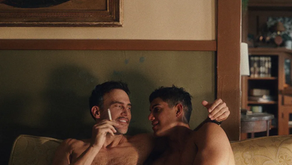Movies: Listen to the voices (2024) by Maxime Jean-Baptiste: A quietly powerful story of grief, drums and healing
- dailyentertainment95

- 2 hours ago
- 6 min read
Echoes of Memory and Music
A lyrical exploration of family loss and musical healing set in French Guiana, this debut by Maxime Jean-Baptiste merges drama and music to tell a story of intergenerational grief and forgiveness.
“Kouté vwa” follows 13-year-old Melrick, who spends the summer with his grandmother Nicole and uncovers the story of her late son Lucas, a drummer whose death fractured the family. Blending drama, documentary tone, and music, the film explores how silence, rhythm, and shared history shape identity.Co-written with Audrey Jean-Baptiste, the work has won 2 awards and received 6 nominations, confirming its artistic impact and emotional resonance. Shot across Belgium, France, and French Guiana, it brings a vivid sense of place and sound rarely seen in cinema.
Why to watch this movie: When Drums Speak Louder Than Words
“Kouté vwa” resonates because of its emotional depth, cultural representation, and innovative use of music as both storytelling and healing. It represents a growing cinematic trend toward personal, hybrid storytelling grounded in post-colonial experience.
Emotional honesty: The film feels lived-in and deeply human. It doesn’t dramatize grief but lets it unfold through quiet gestures, looks, and silences.
Cultural depth: French Guiana becomes more than a backdrop — it’s a living presence, with its music, Creole language, and collective rhythms shaping every scene.
Music as bridge: The sound of drums links generations and memories, acting as the heartbeat of the story. Each rhythm carries a memory, each silence a loss.
Hybrid narrative: By blending fictional storytelling with documentary realism, the film delivers intimacy and truth that purely scripted drama could not achieve.
Visual poetry: Warm tropical light, close-up emotional shots, and naturalistic performances make the film a sensory and immersive experience.
Where to watch: https://www.primevideo.com/detail/0H5BLRJK2VAP06V5N1TKA51NSK/ref=dvm_src_ret_fr_xx_s (France)
Link IMDB: https://www.imdb.com/title/tt32890051/
Link Review: https://cineuropa.org/en/newsdetail/464988/
About movie: https://avilafilm.be/en/film/koute-vwa
What Trend Is Followed: The Rise of Hybrid Cinema and Memory Work
Kouté vwa belongs to a growing cinematic movement where filmmakers blur fiction and documentary to explore personal history, inherited trauma, and cultural identity.
Fact meets fiction: Emotional truths are told through hybrid storytelling that transcends conventional narrative.
Unseen geographies: By situating its story in French Guiana, the film broadens cinema’s global scope.
Post-colonial lens: Private grief becomes a reflection on historical and colonial violence, reclaiming suppressed stories.
Rhythmic structure: Sound replaces dialogue as a narrative thread, echoing trends in sensory and immersive cinema.
Movie Plot: Forgiveness Through Rhythm
Each narrative element of Kouté vwa reflects broader cinematic trends in sensory realism, hybrid storytelling, and emotional minimalism.
Arrival and silence (Trend: Slow cinema & sensory realism):Melrick arrives at his grandmother’s home for the summer, stepping into a world marked by absence. The quiet pacing and observational camera align with the “slow cinema” movement — privileging atmosphere over dialogue.
Echoes of Lucas (Trend: Memory cinema & intergenerational trauma):Through photos, music, and whispers, the story of Lucas — a drummer whose death haunts the family — emerges. This mirrors the global trend of films using memory as narrative engine, such as Memoria (2021).
Curiosity as catalyst (Trend: Child’s-eye storytelling):Melrick’s fascination with drums bridges innocence and awareness. The child’s point of view reflects a trend toward youthful mediators of inherited pain, seen in The Florida Project and Capernaum.
Cycles of violence (Trend: Social realism through allegory):A subplot of revenge echoes structural violence — a microcosm of larger societal wounds. This narrative layer ties into post-colonial allegorical storytelling in cinema from the Global South.
Healing through sound (Trend: Sound as narrative protagonist):Music becomes the film’s emotional language, replacing dialogue with rhythm. The growing “acoustic cinema” trend treats sound as both form and feeling.
Resolution in performance (Trend: Collective healing narratives):The final drum performance transforms grief into community expression, reflecting the rising cinematic motif of art as therapy and cultural survival.
Director’s Vision: Listening as Resistance
Maxime Jean-Baptiste presents cinema as an act of listening — a way to preserve memory, confront trauma, and transform silence into art.
Hybrid storytelling: Combines reenactment, documentary footage, and lived experiences to challenge narrative boundaries.
Cinema as archive: The film becomes a vessel for preserving suppressed Guianese and Caribbean memories.
Rhythm as language: The beat of the drum replaces dialogue, making sound the film’s emotional structure.
Visual intimacy: Natural light, handheld shots, and long takes invite empathy and reflection.
Meditative tone: The pacing mirrors the process of mourning — slow, cyclical, and quietly profound.
Themes: Healing in the Echoes of the Past
The film’s interconnected themes transform family pain into a universal story about memory and renewal.
Grief and memory: Silence becomes both a wound and a form of survival.
Violence and legacy: The death of Lucas reflects deeper societal scars and the intergenerational impact of trauma.
Music as healing: Rhythm becomes ritual — a shared language for processing pain.
Identity and belonging: Melrick’s journey symbolizes diasporic self-discovery and reconnection with roots.
Forgiveness and resilience: The act of listening becomes an act of strength.
Community and continuity: The film honors elders and the passing of wisdom through rhythm and presence.
Key Success Factors: Heart, History, and Hybrid Storytelling
Kouté vwa stands out for its authenticity, artistry, and emotional intelligence.
Authentic experience: Real family members lend the film truth and emotional texture.
Cultural visibility: A rare cinematic voice from French Guiana.
Sound and emotion: The film’s design makes rhythm and silence its most powerful characters.
Critical acclaim: Its strong festival presence affirms its artistic importance.
Distinct directorial vision: Jean-Baptiste’s ability to merge form, feeling, and politics makes his debut notable.
Youthful insight: The story’s perspective through a young boy brings tenderness and hope.
Awards & Nominations: Festival Recognition for Emotional Power
The film has earned 2 wins and 6 nominations, notably at the Locarno International Film Festival, where it received the Special Jury Prize and Special Mention for First Feature. It was also screened at MoMA, RIDM, and Viennale, confirming its growing reputation within the global art-house circuit.
Critics Reception: Quiet Film, Loud Impact
Critical response highlights Kouté vwa as an emotionally rich and culturally significant debut.
Cineuropa (Aurore Engelen): Praises its “intimate and poignant portrayal that fills in the missing images of French Guiana,” commending its hybrid form and deep cultural memory.
Film Verdict (Oris Aigbokhaevbolo): Describes it as “a sobering look at trauma, blackness, and violence in a Guianese neighbourhood,” emphasizing its moral and emotional clarity.
Variety (Pierre Jendrysiak & Leonard Krähmer): Notes the film’s “poetic polyphony of entangled testimony,” celebrating its blend of realism and reflection.
Rotten Tomatoes (Rubén Rosario, Vadim Rizov): Hails it as “a visually arresting portrait of grief and identity,” acknowledging its emotional depth though mentioning its open-ended close.
Overall: Critics admire the film’s emotional precision, cultural specificity, and sonic beauty. Its quiet rhythm and reflective tone are praised as both cinematic and healing, though its unconventional pacing divides some audiences.
Reviews: Sound, Silence, and Sentiment
Reviews from both critics and audiences echo one another — praising its sincerity, craft, and thematic unity.
Cineuropa: Highlights the film’s blend of fiction and archive as a profound act of remembrance.
Film Verdict: Notes its tonal evolution from childlike wonder to confronting collective grief.
Variety: Commends its ability to merge personal and political narratives into a “polyphonic reflection on inherited violence.”
Rotten Tomatoes: Aggregates praise for its beauty, emotional clarity, and innovative soundscape.
Letterboxd (audience): Viewers describe it as “gorgeously shot, rhythmically alive, and emotionally transcendent.”
Overall: Kouté vwa emerges as a film that listens more than it speaks — turning silence, sound, and sorrow into one continuous song of memory.
Movie Trend: Hybrid Cinema of Memory and Place
The film exemplifies a wave of hybrid, memory-driven cinema that merges documentary truth with fictional storytelling. This form prioritizes emotional authenticity over plot, using sound, rhythm, and archival imagery to reclaim cultural narratives. Kouté vwa stands within a lineage of films that turn remembrance into resistance and art into healing.
Social Trend: The Era of Healing and Representation
The film reflects a larger social movement that values representation, reconciliation, and post-colonial awareness. In an age of rediscovered histories and reimagined identities, Kouté vwa embodies a call to collective listening — art as an instrument for healing and cultural restoration.
Final Verdict: A Film to Feel, Not Just Watch
Kouté vwa is a tender, meditative, and courageous debut — a film that transforms silence into rhythm and grief into grace. Maxime Jean-Baptiste crafts a cinematic poem that asks not for understanding, but for empathy.For viewers seeking emotionally intelligent, visually immersive, and culturally rooted cinema, Kouté vwa is an unforgettable experience — a film that leaves echoes long after its final drumbeat fades.
Similar Movies: Films That Sing from the Same Soul
For those drawn to music, memory, and identity-driven cinema:
The Last Black Man in San Francisco (2019): A lyrical portrait of home, race, and belonging.
Rocks (2020): Tender exploration of friendship and survival in adolescence.
Neptune Frost (2021): An Afrofuturist symphony of rhythm and resistance.
Faya Dayi (2021): Dreamlike blend of spiritual searching and historical reflection.
Meditation Park (2017): Quiet study of intergenerational understanding and empowerment.
Each film, like Kouté vwa, listens deeply — transforming memory and emotion into cinematic rhythm.









Comments